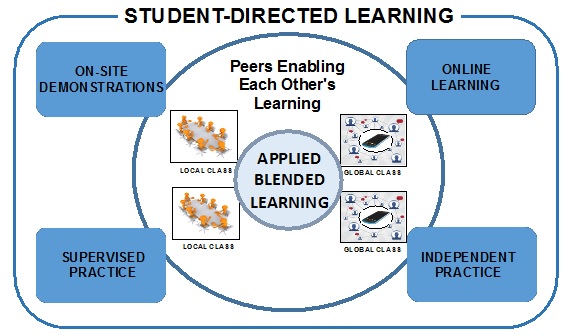The learning sequence advocates the use of four features: visits to see the skills being performed, situations where he/she performs these skills under supervision, mastery of knowledge content, and finally independent skill performance where the level of performance can be assessed.

Online Learning
A world of academic resources is one stream of learning. Beyond the familiar books and journals, now students anywhere can around with a mobile device that holds hundreds of books and videos. If the student desires more, that is a few clicks away. Not just books and videos, but now also the world’s leading professors giving lectures taken years to refine, lectures supported by graphics that cost often one hundred thousand dollars – these too are nearly free and a few clicks away.
Site-based Demonstrations
Visits allow students to see an expert performing a skill. Actual demonstrations allow actions to be observed, questions asked, and context absorbed, so the skill can adeptly be adapted through that multi-textured learning to be adopted back home. It may seem expensive in money and time to travel for visits, but given the grounding and durability of learning, costs are reasonable in today’s age of mass transport. Moreover, when such visits are done with a cohort of students, then there is mentoring during and after the visit as students inform each other about what they saw the expert perform.
Supervised Practice
A learning space that is global allows students to perform skills in a similar manner a laboratory provides chance for supervised practice of the scientific method. Supervised learning can be engaged across the full academic curriculum. As students progress through practice in their competency levels, opportunities for supervised practice will come by connecting to a nongovernmental organization, trade union, or business. In the world there are many varieties of laboratories. For these organizations, the incentive to engage these student learners is that they could be getting a low-cost helper, an apprentice or intern, or in some instances, the student may also pay for this opportunity to understudy.
Independent Practice
The greatest classroom, of course, is life itself. The problem with this “university of hard knocks” is difficulty in providing mentoring to performance. Results come back to the student in hard knocks, but how to transform these to learning? The technology of broadband internet will address this ancient learning dilemma. No longer is the person isolated. The mobile communication device can ring into the learning cohort, and that opens teaching depth. With the potential for near immediate feedback (not like waiting for a professor to grade a paper) multiple peers are possibly poised. Independent performance becomes interdependent performance.
Thus, the university introduces in Applied Blended Learning, where each student can select the optimal for them, complementary modes of learning: knowledge from the Internet, contact with masters, skills developed in real life, and connection to evolving practices. Or, stated in another way, learning is coming to the student through the real world (local community), connecting the world (smart phones), and advancing learning through peer review. As students learn to learn within these, they are learning skills for advancing their practice through the rest of their lives.
